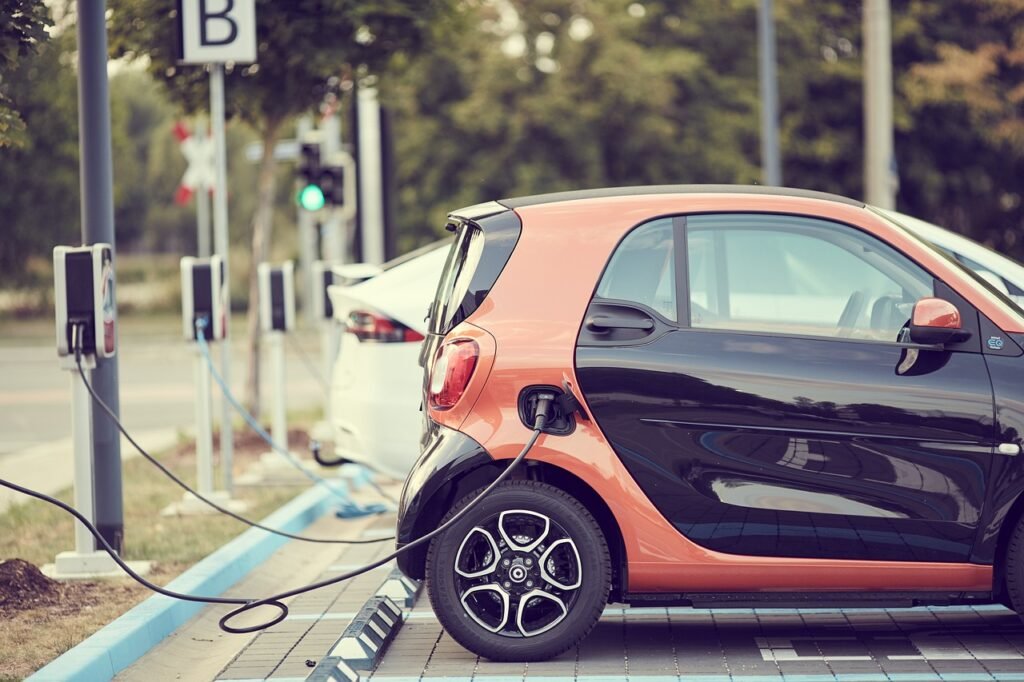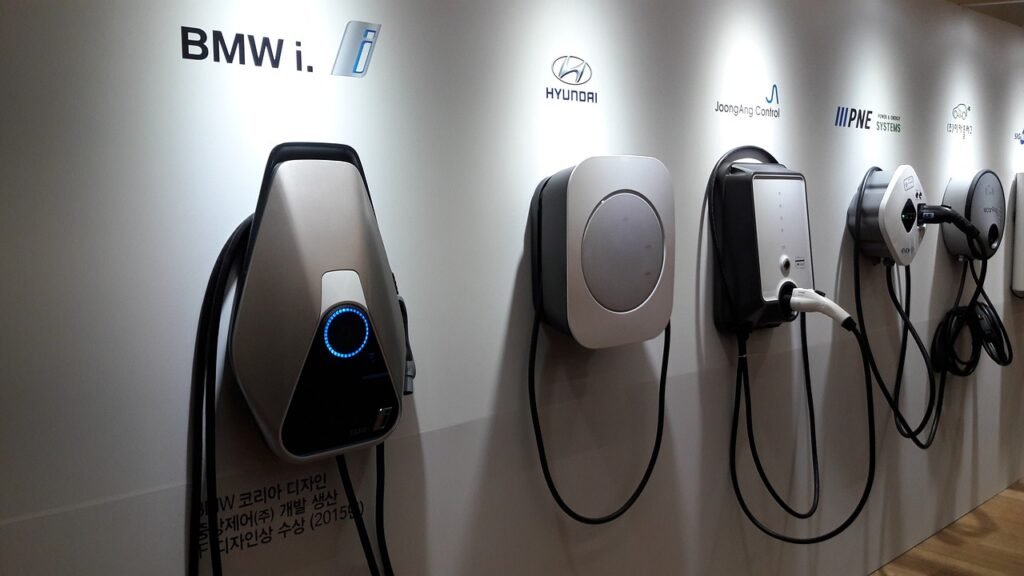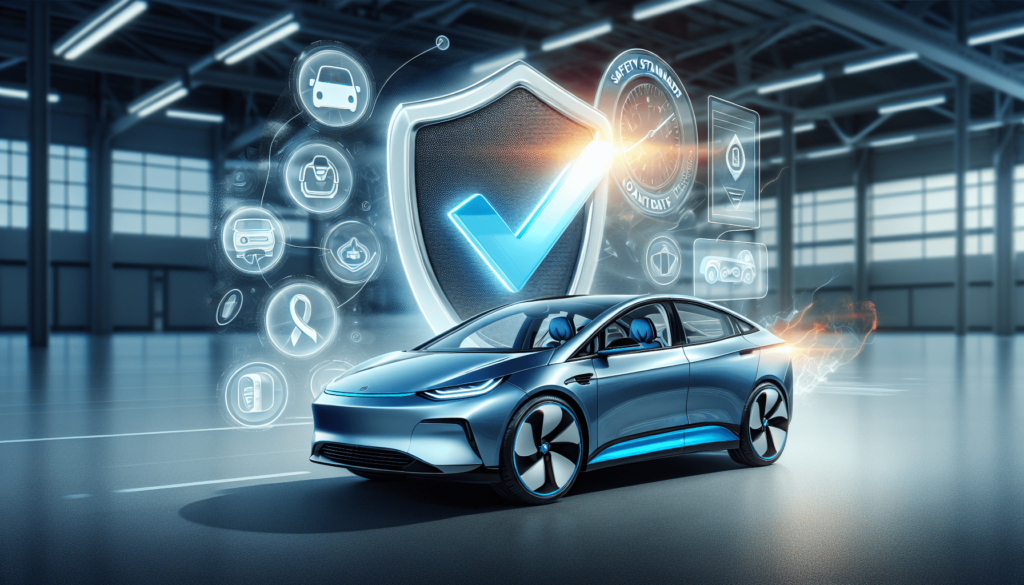Have you ever wondered what safety standards are in place for electric cars? It’s important to understand the measures put forth by the government to ensure the safety of these vehicles on the road. From crash testing to fire safety, the government has implemented a range of regulations that manufacturers must adhere to when producing electric cars. In this article, we will take a closer look at these safety standards and explore how they contribute to making electric cars a secure and reliable mode of transportation. So, let’s dive into the world of electric vehicle safety together!
Crashworthiness
Electric vehicles (EVs) are subject to the same crashworthiness standards as conventional vehicles. Crashworthiness refers to a vehicle’s ability to protect occupants during a crash and minimize the likelihood of serious injury or death. The most important aspects of crashworthiness include frontal impact, side impact, rollover, and crash test ratings.
Frontal Impact
Frontal impact refers to collisions that occur at the front of the vehicle, which are among the most common types of crashes. EVs are designed to withstand frontal impacts by incorporating various safety features and structural reinforcements. These features include reinforced front frames, crumple zones, and advanced restraint systems, such as airbags and seatbelts. Crash tests, conducted by regulatory agencies and independent organizations, evaluate the safety performance of EVs under frontal impact conditions.
Side Impact
Side impact collisions pose a significant risk to vehicle occupants as the sides of the vehicle have less structural protection compared to the front and rear. To enhance side impact safety, EVs are equipped with reinforced side frames, side impact airbags, and side curtain airbags that deploy to cushion and protect occupants during a collision. Crash test ratings for side impact also play a crucial role in evaluating the safety of an electric vehicle.
Rollover
Rollover accidents can be particularly dangerous, especially for taller vehicles with a higher center of gravity. EV manufacturers employ various techniques to enhance rollover resistance and occupant protection. These techniques include lowering the vehicle’s center of gravity by placing heavy components (such as batteries) at the bottom, using specialized suspension systems, and implementing electronic stability control systems. Compliance with government rollover standards ensures that EVs provide adequate protection in the event of a rollover.
Crash Test Ratings
Crash test ratings are essential for consumers to make informed decisions about the safety of electric vehicles. Agencies such as the National Highway Traffic Safety Administration (NHTSA) in the United States and the European New Car Assessment Programme (Euro NCAP) evaluate EVs based on standardized crash tests. These tests assess front, side, and rollover crash performance and assign ratings that help consumers compare the safety of different EV models. Higher crash test ratings indicate a higher level of crashworthiness.
Electrical Safety
Safety in electric vehicles extends beyond crashworthiness and encompasses electrical safety. Electric vehicles utilize high-voltage systems, including batteries and charging mechanisms, which necessitate specific safety standards for these components.
Battery Safety
Battery safety is a critical aspect of electric vehicle design. EV manufacturers implement various measures to prevent battery-related incidents, such as thermal runaway. Battery packs are designed with robust enclosures and thermal management systems to regulate temperature and prevent overheating. Additionally, battery management systems monitor battery health and performance, continuously ensuring safe operation. Compliance with government safety regulations ensures that EV batteries meet rigorous safety standards.
Charging System Safety
Electric vehicle charging systems must comply with safety standards to protect users from electrical hazards. The charging infrastructure includes charging stations, connectors, and cables. Safety features such as ground fault protection, overcurrent protection, and insulation integrity are incorporated into the design of charging systems. These features minimize the risk of electrical shock, short circuits, and other potential hazards during the charging process.
Electric Shock Prevention
Electric vehicles incorporate safety features to prevent electric shock incidents. High-voltage systems are isolated and well-insulated from the vehicle’s chassis, reducing the risk of electric shock to occupants and emergency responders. Furthermore, EV manufacturers provide clear instructions and warning labels to educate users on safe handling and maintenance practices to mitigate electrical hazards.

Fire Safety
Fire safety is a crucial consideration in electric vehicles due to the presence of high-energy batteries. Manufacturers implement multiple safety measures to minimize the risk of fires, while also ensuring effective fire suppression and emergency response procedures.
Battery Thermal Runaway
Battery thermal runaway refers to a rapid and uncontrolled increase in battery temperature, leading to thermal instability and potentially resulting in a fire. EV manufacturers invest in advanced battery management systems to detect and prevent thermal runaway. These systems monitor battery temperature, cell voltage, and other parameters to identify potential issues and trigger protective measures, such as reducing charging power or shutting down the battery pack.
Fire Suppression Systems
To contain and extinguish fires in electric vehicles, manufacturers incorporate advanced fire suppression systems. These systems typically utilize flame retardants, fire-resistant materials, and specialized fire suppression agents. They are designed to respond quickly to fire incidents and prevent the spread of flames to other parts of the vehicle, ensuring occupants have enough time to evacuate safely.
Emergency Response Procedures
Emergency response procedures specific to electric vehicles are essential to ensure effective and prompt action in the event of a fire. First responders need to be well-informed and trained on how to handle electric vehicle incidents safely. Manufacturers collaborate with emergency response agencies to develop comprehensive protocols for extinguishing EV fires and executing rescue operations. These protocols provide step-by-step guidelines for isolating high-voltage systems, disconnecting batteries, and safely extricating occupants from the vehicle.
Pedestrian Safety
When it comes to safety, electric vehicles not only prioritize the protection of occupants but also consider the safety of pedestrians who share the roads. Various technologies and design features contribute to enhanced pedestrian safety.
Audible Vehicle Alert Systems
Electric vehicles, which operate quietly compared to internal combustion engine vehicles, incorporate audible vehicle alert systems to alert pedestrians of their presence. These systems emit sounds, typically designed to mimic the sound of a combustion engine, to notify pedestrians of an approaching vehicle. By providing audible cues, EVs mitigate the risk of pedestrian accidents, especially in low-speed environments where pedestrians may not detect the vehicle’s presence.
Impact Detection and Mitigation
Advanced sensors and detection systems enable electric vehicles to identify potential collisions with pedestrians and implement measures to mitigate the impact. These systems use cameras, radar, and other technologies to detect pedestrians in the vehicle’s path. If a collision is imminent, the EV may activate automatic braking systems or provide warnings to the driver to prevent or reduce the severity of an impact.
Exterior Noise Requirements
To ensure pedestrian safety, certain regulations mandate minimum levels of exterior noise emission for electric vehicles. By adhering to these requirements, EVs generate audible signals that pedestrians recognize, enabling them to be alert and take appropriate actions when crossing streets or interacting with vehicles. The aim is to compensate for the inherently quieter nature of electric vehicles and maintain the safety standards established for pedestrian-vehicle communication.

Occupant Protection
Ensuring occupant protection is a primary concern for electric vehicle manufacturers. EVs provide various safety features and systems to reduce the risk of injuries for both drivers and passengers.
Safety Belts
Safety belts remain one of the most critical and effective safety features in any vehicle, including electric cars. EVs come equipped with seat belts that meet stringent safety standards. These belts are designed to minimize the risk of occupants moving forward or being ejected from the vehicle in the event of a crash. Some electric vehicles also offer additional safety features such as pre-tensioners and seat belt reminders to optimize belt effectiveness.
Child Restraint Systems
Electric vehicles prioritize the protection of young passengers by integrating child restraint systems that meet safety regulations. These systems include child safety seats and booster seats, designed to secure children and provide appropriate restraint in line with their age and size. By utilizing advanced child restraint systems, electric vehicles ensure the safety of young passengers during travel.
Airbags
Electric vehicles utilize a variety of airbags strategically placed throughout the cabin to provide additional protection in the event of a crash. These airbags are designed to deploy rapidly upon impact and act as a cushion between occupants and hard surfaces, minimizing the risk of injuries. The number and placement of airbags in electric vehicles are carefully determined based on crash test performance and regulatory requirements to maximize occupant safety.
Active Safety Features
Active safety features in electric vehicles utilize advanced technologies to prevent accidents, minimize the risk of collisions, and enhance overall road safety.
Antilock Braking System (ABS)
Antilock Braking System (ABS) is a fundamental active safety feature in electric vehicles. ABS prevents wheel lock-up during emergency braking situations, allowing drivers to maintain control of their vehicles and steer to avoid obstacles. By modulating brake pressure to individual wheels, ABS enhances vehicle stability and reduces the risk of accidents caused by skidding or loss of steering control.
Electronic Stability Control (ESC)
Electronic Stability Control (ESC) is another essential active safety feature found in electric vehicles. ESC continuously monitors the vehicle’s stability and detects any loss of control or instability. If the system detects an imminent skid or loss of control, it automatically applies individual brakes and adjusts engine power to help the driver regain control. ESC significantly enhances vehicle stability, especially during hazardous driving conditions or evasive maneuvers.
Collision Avoidance Technology
Collision avoidance technologies in electric vehicles employ advanced sensors, cameras, and radar systems to detect potential collision hazards and warn drivers or take proactive measures to prevent accidents. These technologies include forward collision warning systems, automatic emergency braking, lane departure warning systems, and blind-spot monitoring. By providing drivers with real-time alerts and assistance, collision avoidance technology helps prevent or mitigate the severity of accidents.

Vehicle Structure
The structure of electric vehicles plays a crucial role in ensuring occupant safety during a crash. Manufacturers prioritize stability and structural integrity, incorporating various engineering measures to achieve optimal safety performance.
Stability and Structural Integrity
Electric vehicle manufacturers employ advanced engineering techniques to enhance overall vehicle stability and structural integrity. This involves the use of high-strength materials, such as advanced steel alloys or aluminum, to form a sturdy and robust vehicle structure. By optimizing the vehicle’s structural design and considering factors such as weight distribution, EV manufacturers strive to achieve maximum crashworthiness and minimize the risk of deformation or collapse during a crash.
Crash Energy Absorption
During a crash, a significant amount of energy is generated. Electric vehicles are engineered to absorb and dissipate this crash energy efficiently. Dedicated crumple zones are strategically placed in the front and rear of the vehicle to absorb impact forces and reduce the transfer of energy to the occupants. Additionally, specialized engineering techniques are employed to direct crash forces around the cabin area, preserving the structural integrity and protecting occupants from severe injury.
Safety Labeling
Safety labeling in electric vehicles ensures that users are well-informed about potential hazards and the necessary precautions to take.
High-Voltage Warning Labels
Electric vehicles utilize high-voltage systems, posing potential risks to those not familiar with their operation. High-voltage warning labels are prominently displayed in EVs, providing clear visual cues to users and first responders about the presence of high-voltage components. These labels serve as a reminder to exercise caution and follow proper safety procedures when interacting with the vehicle or during emergency situations.
Emergency Procedures Labels
Emergency procedures labels in electric vehicles outline the necessary steps to be taken in the event of an emergency or accident. These labels provide guidance to both vehicle occupants and first responders on actions such as how to shut down high-voltage systems, disconnect the battery, or perform extrication procedures safely. By providing concise instructions and visual cues, emergency procedures labels facilitate the efficient and well-informed response during critical situations.

Emergency Response
Effective emergency response procedures specific to electric vehicles are crucial to ensure the safety of occupants and first responders.
Emergency EV Shutdown
Electric vehicles are equipped with emergency shutdown procedures to quickly and safely isolate high-voltage systems in the event of an accident or fire. By following these procedures, first responders can prevent the risk of electric shock and further damage to the vehicle. Manufacturers work closely with emergency response agencies to develop comprehensive guidelines and training programs for the correct execution of emergency shutdown procedures.
First Responder Training
Given the unique aspects and potential hazards associated with electric vehicles, specialized training is essential for first responders. Training programs educate firefighters, paramedics, and other emergency personnel on the specific characteristics of electric vehicles, potential risks, and the proper protocols to handle incidents involving EVs. Through comprehensive training, first responders gain the knowledge and skills necessary to respond effectively and safely in emergency situations involving electric vehicles.
Rescue and Extrication Methods
Electric vehicles require specific rescue and extrication methods due to the presence of high-voltage systems and advanced materials. First responders are trained to identify high-voltage components, safely disconnect batteries, and take precautions to avoid electric shock during rescue operations. Rescue tools and techniques have evolved to adapt to the structural characteristics of electric vehicles, ensuring efficient extrication procedures while minimizing the risk of injury to both occupants and rescuers.
Regulatory Compliance
Electric vehicle manufacturers must comply with various safety regulations and standards set by government agencies to ensure the safety of their vehicles.
National Highway Traffic Safety Administration (NHTSA)
The National Highway Traffic Safety Administration (NHTSA) in the United States sets and enforces safety standards for motor vehicles, including electric cars. NHTSA conducts crash tests, evaluates safety performance, and establishes regulations to enhance vehicle safety. Compliance with NHTSA standards is mandatory for all electric vehicle manufacturers operating in the United States.
Federal Motor Vehicle Safety Standards (FMVSS)
The Federal Motor Vehicle Safety Standards (FMVSS) outline specific safety requirements for vehicles in the United States. Electric vehicles must meet these standards, which cover aspects such as crashworthiness, occupant protection, electrical safety, lighting, tires, and many other safety-related features. By complying with FMVSS, electric vehicle manufacturers ensure their vehicles adhere to minimum safety requirements set by the government.
The European New Car Assessment Programme (Euro NCAP)
The European New Car Assessment Programme (Euro NCAP) evaluates the safety performance of vehicles sold in Europe, including electric cars. Euro NCAP conducts extensive crash tests and assesses key safety aspects to assign safety ratings to vehicles. Electric vehicle manufacturers targeting the European market undergo Euro NCAP evaluations to demonstrate their commitment to safety and showcase the reliability of their vehicles to consumers.
In conclusion, electric vehicles are subject to comprehensive safety standards set by government agencies to ensure the protection of both occupants and pedestrians. From crashworthiness to electrical safety, fire safety to pedestrian safety, and regulatory compliance, various aspects contribute to the overall safety of electric vehicles. By adhering to these standards and incorporating advanced safety features and technologies, electric vehicle manufacturers aim to enhance road safety and promote the adoption of sustainable transportation options.

